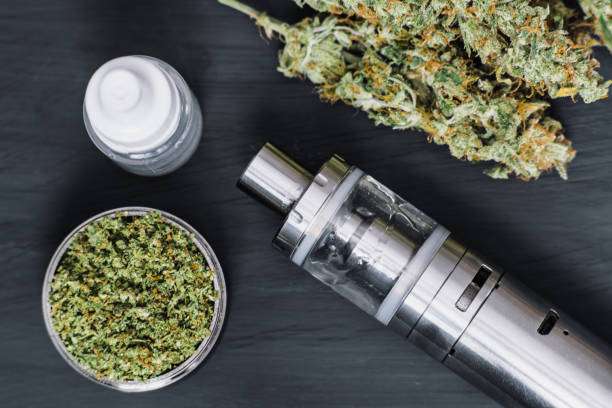Cannabis vaping has become increasingly popular in recent years, providing a cleaner, smoother alternative to traditional smoking methods. The demand for cannabis vape hardware has risen dramatically, offering consumers a wide range of options in terms of devices and accessories. This article will explore the different types of cannabis vape hardware, how they work, and what to look for when choosing a device.
What is Cannabis Vape Hardware?
Cannabis vape hardware refers to the tools and devices used to vaporize cannabis. Vaping involves heating cannabis concentrates or flower to a temperature that releases the active compounds—such as THC and CBD—into a vapor without combustion. This results in a smoother and less harmful inhalation experience compared to smoking. The term “cannabis vape hardware” can encompass a variety of components, including vaporizers, cartridges, tanks, and accessories. These devices work by using heat to vaporize the cannabis material, offering an efficient and discreet way to consume cannabis.
Types of Cannabis Vape Hardware
There are several different types of cannabis vape hardware, each designed to work with specific cannabis forms, such as flowers, concentrates, or pre-filled cartridges. Below, we will look at the primary types of vape hardware available today.
1. Vaporizers
Vaporizers are one of the most common types of cannabis vape hardware. They come in a variety of shapes and sizes, and they can be used to vaporize either cannabis flower or concentrates.
a. Portable Vaporizers
Portable vaporizers are compact, battery-powered devices that are perfect for on-the-go cannabis consumption. These vaporizers typically feature advanced temperature controls, allowing users to set the temperature for optimal vaporization of the cannabis material. Portable vaporizers can be divided into two categories: convection and conduction vaporizers.
- Convection Vaporizers: These use hot air to heat the cannabis material evenly, providing a smoother vapor with fewer harsh flavors.
- Conduction Vaporizers: In these devices, the cannabis is heated by direct contact with the heating element, which tends to heat the material more quickly but may not provide as even of a vaporization.
b. Desktop Vaporizers
Desktop vaporizers are larger and typically more powerful than portable devices. They are designed for home use and are often plugged into a wall outlet. Desktop vaporizers provide precise temperature control, larger vapor clouds, and more consistent results. These devices are ideal for users who prefer to vape large quantities of cannabis and don’t need the portability.
2. Vape Pens
Vape pens are the most common form of cannabis vaping hardware, and they are specifically designed for use with cannabis oil cartridges. These devices are small, discreet, and easy to use. They consist of three main components:
- Battery: This powers the device and provides heat to the atomizer.
- Atomizer: The atomizer is a small heating element that vaporizes the cannabis oil within the cartridge.
- Cartridge: The cartridge holds the cannabis concentrate, such as THC or CBD oil, which is vaporized by the atomizer when heated.
Vape pens are popular due to their ease of use, portability, and the variety of cannabis oils available for them.
How Cannabis Vape Hardware Works
The general principle behind cannabis vaping involves heating the cannabis material (flower, concentrate, or oil) to a point where the active compounds evaporate into vapor, which can then be inhaled. However, the technology and methods behind different devices can vary.
Temperature Control and Vaporization
The key to efficient vaporization is controlling the temperature. When cannabis is heated, cannabinoids such as THC and CBD are released as vapor. However, they only become active at specific temperatures:
- THC vaporizes around 157°C (315°F)
- CBD vaporizes around 160°C (320°F)
High-quality cannabis vaporizers come equipped with temperature controls that allow users to adjust the heat according to their preferences and the type of cannabis they are using. This enables consumers to enjoy optimal vapor production without burning the material.
The Atomizer
The atomizer is the heart of most cannabis vape hardware. In vape pens, the atomizer is responsible for heating the cannabis concentrate or oil inside the cartridge. It typically consists of a coil, a wick, and a heating element. The atomizer heats up when the user activates the battery, which, in turn, vaporizes the cannabis oil.
What to Look for in Cannabis Vape Hardware
When selecting cannabis vape hardware, there are several factors to consider to ensure you get the best experience. The following are some important things to keep in mind:
1. Type of Cannabis Material
Different vaporizers and pens are designed to work with specific types of cannabis material. Some devices work with dry herb (flower), while others are designed for concentrates or oils. Make sure that the hardware you choose is compatible with the cannabis form you intend to use.
2. Temperature Control
For an optimal vaping experience, it’s essential to choose a device that allows you to control the temperature. Different cannabinoids vaporize at different temperatures, so having control over the heat will help you maximize flavor, potency, and smoothness. High-quality vaporizers typically offer adjustable temperature settings, while lower-end models may have a fixed heat setting.
3. Battery Life
If you choose a portable vaporizer or vape pen, consider the battery life. The longer the battery lasts, the less often you will need to recharge. For on-the-go users, a longer battery life is particularly important. Look for vaporizers and pens that offer fast charging and long-lasting power.
4. Ease of Use and Portability
Cannabis vaping hardware should be user-friendly and easy to maintain. Vaporizers with simple interfaces, easy loading mechanisms, and straightforward cleaning procedures will enhance your overall experience. For portability, smaller devices like vape pens are easy to carry and use anywhere, while larger desktop vaporizers may require more space and are better suited for home use.
5. Vapor Quality
The quality of the vapor is a critical factor in any cannabis vaping experience. Look for hardware that provides smooth, flavorful vapor without harshness or burnt tastes. Devices with higher-quality atomizers and heating elements tend to produce superior vapor. In addition, vaporizers with proper airflow systems can help create a smooth and enjoyable vaping experience.
The Future of Cannabis Vape Hardware
As cannabis consumption continues to rise, the demand for better, more efficient vape hardware is expected to grow. New technologies are being developed to enhance the vaping experience, including devices with improved temperature control, faster heating elements, and greater compatibility with various cannabis forms. Additionally, there is a growing emphasis on creating devices that offer better flavor, more potent vapor, and longer battery life. The trend towards sleek, discreet, and easy-to-use devices also points to a future where cannabis vape hardware is even more integrated into the lifestyles of users, providing seamless and personalized experiences.
Conclusion
Cannabis vape hardware offers an efficient and less harmful way to consume cannabis compared to smoking. With a range of devices—from portable vaporizers and vape pens to powerful desktop units—there is something to suit every user’s needs. When choosing cannabis vape hardware, consider factors such as the type of cannabis material, temperature control, battery life, and vapor quality. As technology continues to evolve, the future of cannabis vaping looks even more promising, with innovations designed to enhance the user experience.
Medical Disclaimer:
The information provided in these blog posts is intended for general informational and educational purposes only. It is not a substitute for professional medical advice, diagnosis, or treatment. Always seek the advice of your physician or other qualified healthcare provider with any questions you may have regarding a medical condition. The use of any information provided in these blog posts is solely at your own risk. The authors and the website do not recommend or endorse any specific products, treatments, or procedures mentioned. Reliance on any information in these blog posts is solely at your own discretion.














